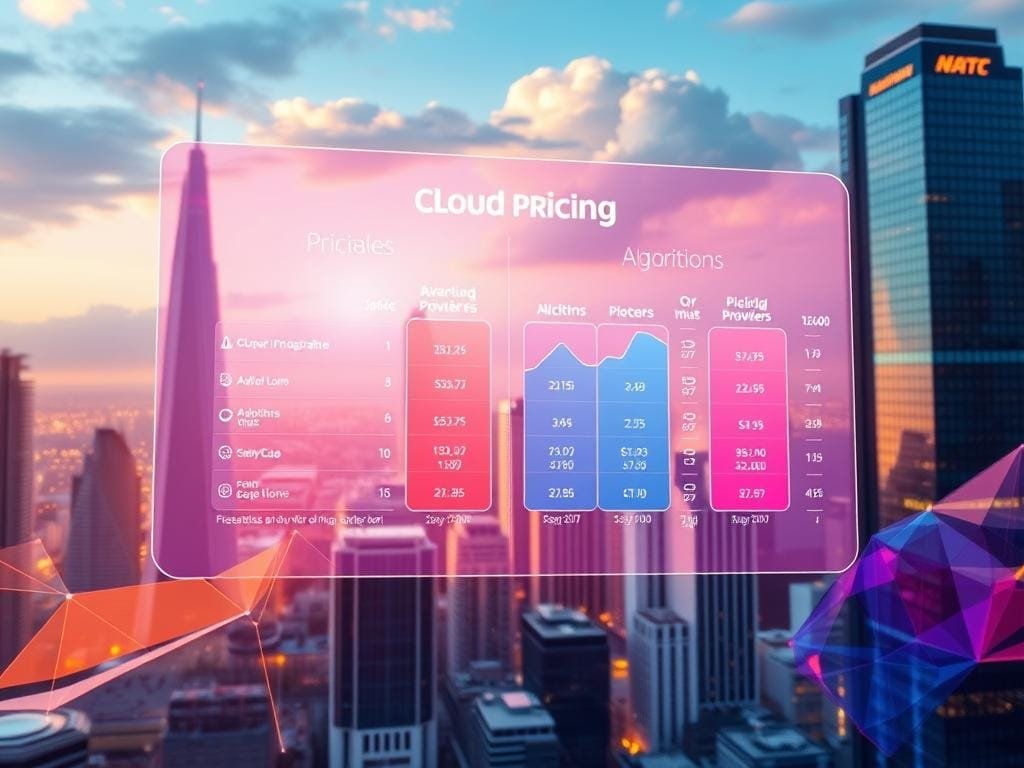The cloud computing world is getting more exciting, with the global market set to hit $1 trillion by 2027. By 2023, it had already passed $500 billion. This growth is mainly thanks to Amazon Web Services (AWS), Microsoft Azure, and Google Cloud Platform (GCP). These services are likely part of your daily work, but knowing their strategies and market share is key to staying ahead.
AWS is a big player, handling lots of data storage for big companies. Azure is a favorite among 29% of corporations because it works well with Microsoft products. Google Cloud is leading in AI analytics, growing 45% each year. Keeping up with these changes is vital. For more on tech careers, check out our article on top tech careers in 2025.
Key Takeaways
- AWS, Azure, and GCP dominate the cloud computing market.
- The global cloud market is expected to reach $1 trillion by 2027.
- Cloud platforms drive 68% of infrastructure development projects.
- Demand for cloud architects and developers will outpace supply by 2025.
- Salaries for cloud architects range from $130,000–$180,000 annually.
Introduction to Cloud Computing in 2025
In 2025, the cloud computing world is buzzing with activity. Many cloud service providers are competing for the top spot. It’s important for businesses to know the cloud computing landscape.
What is Cloud Computing?
Cloud computing means using the internet to access computing services. This includes servers, storage, databases, software, and analytics. It lets businesses grow and innovate easily by using shared resources.
Key characteristics of cloud computing include:
- On-demand self-service
- Broad network access
- Resource pooling
- Rapid elasticity
- Measured service
Importance of Cloud Providers
Cloud providers like AWS, Azure, and GCP offer many services. These services help businesses grow and innovate. They also reduce costs and improve scalability.
The importance of cloud providers can be seen in several areas:
- Scalability: Cloud providers offer scalable solutions that can grow with your business.
- Innovation: By providing access to advanced technologies like AI and machine learning, cloud providers enable businesses to innovate.
- Cost-effectiveness: Cloud services can reduce the need for upfront capital expenditures on hardware and software.
A Brief History of Cloud Services
Cloud computing has changed a lot in the last 20 years. It started with grid and utility computing, then Amazon Web Services (AWS) launched in 2002. Now, cloud services include IaaS, PaaS, and SaaS.
Today, cloud services are a big part of IT strategies worldwide. As we look to 2025, the cloud will keep playing a key role.
Key Players in the Cloud Market
Knowing the top players in the cloud market is key for businesses wanting to use cloud technology. The cloud world is led by a few big names. Each offers a variety of services for different business needs.
Amazon Web Services (AWS)
AWS leads the market with about 32% share. It has a wide range of cloud services like computing, storage, and analytics. AWS is known for being scalable, reliable, and having many services.
- Compute Services: EC2, Lambda
- Storage Services: S3, Glacier
- Database Services: RDS, DynamoDB
Microsoft Azure
Microsoft Azure is the second biggest, with about 23% share. Azure has many cloud services, including computing and AI. It’s popular with companies already using Microsoft products.
- Compute Services: Virtual Machines, Functions
- Storage Services: Blob Storage, File Storage
- AI and Machine Learning: Azure Machine Learning
Google Cloud Platform (GCP)
GCP has about 10% of the market. It’s known for its data analytics and machine learning. GCP offers services like computing and storage.
- Compute Services: Compute Engine, Cloud Run
- Storage Services: Cloud Storage, Persistent Disk
- Data Analytics: BigQuery, Dataflow
IBM Cloud
IBM Cloud is another big name. It offers services like AI and blockchain. IBM Cloud is known for its enterprise-grade services and hybrid cloud support.
- AI and Machine Learning: Watson
- Blockchain: IBM Blockchain
- Enterprise Applications: SAP on IBM Cloud
For businesses wanting to save on cloud costs, knowing the pricing of these providers is key. You can learn more about saving on AWS, Azure, and GCP here.

Emerging Cloud Providers to Watch
Several new players are making waves in the cloud world. They offer competitive services and innovate in areas the big names haven’t touched yet.
Oracle Cloud
Oracle Cloud is a big name in the enterprise world. It provides top-notch services for complex business needs. Features like autonomous databases and AI-driven analytics are highlights.
Key Features of Oracle Cloud:
- Autonomous Database
- Advanced Security
- Integrated AI and Machine Learning
DigitalOcean
DigitalOcean is a hit with developers for its ease and cost-effectiveness. It has a user-friendly interface and services perfect for startups and growing businesses.
Why Choose DigitalOcean?
- Simple, intuitive control panel
- Affordable pricing models
- Robust community support
Alibaba Cloud
Alibaba Cloud is a big player, mainly in Asia. It offers a wide range of cloud services, focusing on AI and big data analytics.
Alibaba Cloud’s Strengths:
- Comprehensive suite of cloud services
- Strong AI and big data capabilities
- Global network with a strong presence in Asia
Cloud Service Models Explained
Exploring cloud computing means knowing the different service models. There are three main models, each for different business needs.
Infrastructure as a Service (IaaS)
IaaS gives you virtual computing resources over the internet. You manage servers, storage, and networking without physical hardware. It’s great for businesses with changing needs.
Benefits include saving money and scaling quickly. You only pay for what you use. Top cloud providers like top cloud providers offer IaaS.
Platform as a Service (PaaS)
PaaS gives a full platform for developing and running apps over the internet. It includes tools and infrastructure, so you can focus on your apps.
It’s best for development teams. It makes app development faster and cheaper. It supports many programming languages and frameworks.
Software as a Service (SaaS)
SaaS lets you use software applications over the internet. You don’t need to install or maintain software locally. It’s flexible and convenient.
It’s good for cutting software costs and making it easier to access. The service provider handles updates and maintenance.

| Service Model | Description | Key Benefits |
|---|---|---|
| IaaS | Virtualized computing resources | Cost savings, scalability |
| PaaS | Platform for developing applications | Streamlined development, reduced costs |
| SaaS | Software applications over the internet | Reduced software costs, improved accessibility |
Knowing these cloud service models is key to a good cloud strategy. Choosing the right one helps you make the most of your cloud investment and succeed in business.
Security Features in Cloud Services
Cloud services have become more popular, making security a top priority. Providers are working hard to improve their security features. If you’re thinking about moving your business to the cloud, it’s important to know what security options are available.
Data Encryption Techniques
Cloud providers use strong data encryption techniques to keep your data safe. For example, AWS uses SSL/TLS for data moving and AES-256 for data stored. Microsoft Azure and Google Cloud Platform (GCP) also have top-notch encryption to protect your data.
Compliance and Regulations
Cloud providers must follow strict rules like GDPR, HIPAA, and PCI-DSS. Look for providers with compliance certifications and know the rules they follow. Big cloud providers have teams for compliance and tools to help you stay in line.
Cybersecurity Measures
Cloud providers also have many cybersecurity measures like firewalls and regular checks. You can make your security even better with extra steps like multi-factor authentication and identity access management.
Want to learn more about using cloud services wisely? Check out the differences between hybrid cloud and multi-cloud strategies to find the best fit for your business.
Cost Comparisons Among Cloud Providers
As more businesses move to the cloud, knowing the costs of different providers is key. Cloud computing costs can be tricky, with many pricing models to consider.
Pricing Structures and Models
Cloud providers have various pricing models to fit different business needs. For example, Amazon Web Services (AWS) uses a pay-as-you-go model. Microsoft Azure offers both subscription-based and pay-as-you-go options. It’s important to understand these models to manage your cloud costs well.
For a detailed look at pricing, check out cloud pricing comparison guides. They help businesses choose the right cloud investment.
| Cloud Provider | Pricing Model | Key Features |
|---|---|---|
| AWS | Pay-as-you-go | Scalability, Wide range of services |
| Microsoft Azure | Subscription-based & Pay-as-you-go | Integration with Microsoft products, Hybrid cloud support |
| Google Cloud Platform | Pay-as-you-go | AI and Machine Learning capabilities, Competitive pricing |
Hidden Costs to Consider
There are hidden costs to think about when choosing cloud providers. These include data transfer, storage, and extra service costs.
“The total cost of ownership for cloud services extends beyond the initial pricing. It’s vital to consider all costs to avoid unexpected expenses.”
For instance, some providers might charge extra for data transfer between regions. They might also charge for services like data analytics tools. Knowing these costs helps avoid surprises on your cloud bill.
Understanding Total Cost of Ownership
To really get the cost of cloud services, you need to understand the Total Cost of Ownership (TCO). TCO includes direct costs of cloud services and indirect costs like management and maintenance.
Guides on AI tools for developers can help. They show how different providers support development and deployment, affecting the overall cost.

By looking at TCO and both direct and indirect costs, businesses can make better cloud investment choices. This ensures they pick a provider that fits their financial and operational needs.
The Role of Hybrid and Multi-Cloud Strategies
In today’s fast-paced digital world, companies are turning to hybrid and multi-cloud strategies. They do this to meet their diverse IT needs. This shift is driven by the need for flexibility, scalability, and cost-effectiveness in managing IT resources.
Understanding Hybrid Cloud
A hybrid cloud combines on-premises infrastructure with cloud services. This lets businesses use the best of both worlds. They can keep sensitive data safe while using public cloud services for less critical tasks.
The hybrid cloud model has many benefits. It offers improved flexibility, better disaster recovery, and optimization of existing investments.
Benefits of Multi-Cloud Approaches
Using a multi-cloud strategy means using multiple cloud providers for different needs. This approach helps avoid vendor lock-in, improves resilience, and uses the strengths of various cloud services.
Some key benefits of multi-cloud strategies include:
- Enhanced flexibility and choice
- Improved risk management
- Optimized performance and cost
- Innovation through access to diverse cloud services
For more insights on the future of cloud computing, you can explore the hybrid and multi-cloud strategies discussed by industry experts.
Best Practices for Implementation
Implementing hybrid and multi-cloud strategies needs careful planning and execution. Here are some best practices to consider:
| Best Practice | Description |
|---|---|
| Assess Business Needs | Evaluate your organization’s IT requirements and identify the most suitable cloud environments. |
| Ensure Interoperability | Choose cloud providers that offer seamless integration and data portability. |
| Implement Robust Security | Develop a complete security strategy that covers all cloud environments. |
| Monitor and Optimize | Continuously monitor your cloud usage and optimize resources for cost and performance. |
By following these best practices, organizations can successfully implement hybrid and multi-cloud strategies. These strategies meet their evolving business needs.
Trends Shaping the Future of Cloud Computing
Several key trends are emerging in cloud computing. Staying ahead of these trends is essential to fully utilize cloud computing services. These trends are influenced by technological advancements and changing business needs.

Artificial Intelligence Integration
Artificial Intelligence (AI) is a major trend in cloud computing. AI is making cloud computing services more efficient, secure, and personalized. Forbes notes that AI is driving innovation in the cloud sector.
Expect to see AI-driven features like predictive analytics and automated problem-solving in cloud services. These features will help businesses make better decisions and work more efficiently.
Sustainability and Eco-Friendliness
The trend of sustainability and eco-friendliness is also important in cloud computing. As environmental concerns grow, leading cloud providers are adopting sustainable practices. They are using renewable energy and improving data center efficiency.
Choosing cloud services that are eco-friendly is key. It helps the environment and can also save you money in the long run.
Edge Computing Developments
Edge computing is another trend changing cloud computing. It involves processing data closer to its source, reducing latency. This is vital for applications like IoT devices and autonomous vehicles.
Edge computing can help reduce data transmission costs and improve system performance. As it evolves, expect to see more innovative uses of this technology.
Customer Support and Service Quality
When choosing a cloud provider, customer support and service quality are key. The support you get can greatly affect your experience and success. It’s important to consider this when making your decision.
Technical Support Options
Cloud providers like AWS, Azure, and GCP offer different support options. These include:
- 24/7 Support: Many providers offer support all day, every day to quickly solve urgent problems.
- Multiple Communication Channels: Support is available through phone, email, and live chat.
- Dedicated Support Teams: Some providers have special teams for big customers or important apps.
When looking at support options, think about how fast they respond and how well they know their stuff. Fast response times and knowledgeable staff are very important for solving problems quickly.
User Experience and Satisfaction
User experience and satisfaction are linked to customer support quality. Cloud providers with easy-to-use interfaces, good documentation, and proactive support tend to make customers happier. Important things to look at include:
- Ease of Use: How simple is it to use the provider’s platform and manage your resources?
- Documentation Quality: Are the provider’s guides clear, complete, and current?
- Proactive Support: Does the provider watch over your account and alert you to possible problems?
Community Resources and Documentation
Community resources and documentation also play a big role in your cloud experience. Look for providers that offer:
- Extensive Documentation: Detailed guides, tutorials, and API documentation.
- Active Community Forums: Forums where you can ask questions, share experiences, and get help from others.
- Training and Certification Programs: Ways to improve your skills and knowledge through training and certification.
By looking at these aspects of customer support and service quality, you can make a better choice. This will help you find a cloud provider that meets your needs and improves your cloud experience.
Conclusion: Choosing the Right Cloud Provider
Choosing the right cloud provider is key in today’s complex cloud computing world. The cloud wars of 2025 show how providers are innovating and focusing on customers.
Assessing Your Business Needs
First, you need to know what your business needs. Look at things like scalability, security, and cost. This will help you pick the best cloud provider for you, like AWS, Azure, or GCP.
Future-Proofing Your Cloud Strategy
Staying up-to-date with new trends and tech is important. As cloud computing grows, providers must keep innovating and adapting.
By carefully looking at your options and keeping up with changes, you can make smart choices. This way, you can succeed in the fast-changing cloud world.
FAQ
What are the top cloud providers in 2025?
In 2025, the top cloud providers will be Amazon Web Services (AWS), Microsoft Azure, and Google Cloud Platform (GCP). IBM Cloud will also be a major player. Newcomers like Oracle Cloud, DigitalOcean, and Alibaba Cloud are making waves too.
What is the difference between IaaS, PaaS, and SaaS?
IaaS gives you virtual computing resources. PaaS is for developing and deploying apps. SaaS lets you use software over the internet. Each offers different levels of control and management.
How do cloud providers ensure security in their services?
Cloud providers like AWS, Azure, and GCP use strong security. They use data encryption and follow regulations. They also have advanced cybersecurity to protect your data and keep their services safe.
What are the benefits of a hybrid cloud strategy?
A hybrid cloud strategy lets businesses use the best of different clouds. It improves flexibility and resource use. It also helps keep sensitive data and apps safe.
How do I choose the right cloud provider for my business?
To pick the right cloud provider, first figure out what your business needs. Look at what each provider offers. Think about cost, security, and scalability. Choose a provider that fits your goals and needs.
What are the emerging trends in cloud computing?
New trends in cloud computing include artificial intelligence and sustainability. Edge computing is also growing. These trends will shape the future of cloud services and drive innovation.
How do cloud providers support their customers?
Cloud providers offer many support options. They have technical support, user guides, and community resources. These help customers solve problems, use their services better, and get the most value.
What is the total cost of ownership for cloud services?
The total cost of cloud services includes direct and indirect costs. Direct costs are what you pay for the services. Indirect costs are things like personnel and training. You need to consider all these costs to make sure it’s worth it.
Can I use multiple cloud providers simultaneously?
Yes, using multiple cloud providers is called a multi-cloud approach. It lets businesses use AWS, Azure, and GCP together. This improves flexibility and reduces dependence on one provider.
How do cloud providers address compliance and regulatory requirements?
Cloud providers take many steps to meet compliance and regulations. They use data encryption, access controls, and get compliance certifications. This ensures their services meet the necessary standards.
